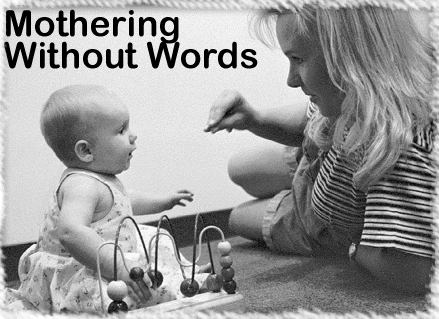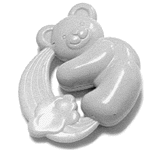
How Hearing Mothers and Deaf Infants Communicate
by Terry Brenner
When her daughter Sally was born, Marianne was ecstatic. She’d been waiting for years to have a child and at last, here she was-pink, wriggly, cooing, everything Marianne had hoped for, from the fuzzy blonde hair to the gummy smile. But in the first several months, something began to nag Marianne. When she made clucking or cooing sounds to Sally, she didn’t respond. She didn’t utter a first word when she was a one-year-old. And at eighteen months, when other children were learning new words by the day, Sally didn’t speak at all. When Marianne mentioned her concerns to her pediatrician, he told her not to worry-she was simply being over-protective.
Then, when Sally was two, Marianne took her to a parade. As the marching band came toward them with shrieking horns and thumping drums, Marianne looked down at her daughter. She was calmly staring back at her, not blinking, not turning her head right or left. It was then Marianne knew: Her daughter was deaf. Marianne was devastated.
The anecdote above is fictitious, but it reflects the surprise and bewilderment many hearing parents feel when they discover their child is deaf. Ninety percent of deaf babies are born to hearing parents, most of whom never have had to communicate with a deaf person. And because infant deafness has been a neglected area in disability research, little is known about ways to help those parents learn to interact with their infants.
Lynne Koester, a psychology professor at UM, is working to change that. For the past ten years Koester has been studying interactions of hearing mothers with their deaf babies. She’s been looking also at deaf mothers’ interactions with their infants, hoping to understand the kinds of communication strategies that could help hearing parents.

Diagnosing Deafness
To most parents, a deaf infant at first appears to be no different from any other baby. “Deaf babies vocalize and sound very much like hearing babies,” Koester says. “Often it’s not until the baby fails to develop spoken language that deafness is diagnosed.”
In the past, deaf babies often weren’t diagnosed until they were two or three years of age, she says. Because the earliest interactions between parent and infant are critical in the child’s socio-emotional development, she says delayed diagnosis could harm the infant in important ways. “If a child doesn’t have reciprocal interactions with the important caregivers in its life at an early age,...that can hinder emotional attachments later on,” she says.
While delayed diagnosis can harm the deaf child, getting the diagnosis also can be very distressing for the hearing parents, and that in turn may affect the child.
“Mothers initially may be depressed about their infant’s deafness,” she says, “and this can have a negative impact on interactions until the mother adjusts.” Depressed mothers often use little touching or facial animation in their interactions, both of which are important ways of “talking” to babies. These mothers need help in learning to communicate with their babies, Koester says, and a crucial factor is the amount of support they get from family, friends, professionals, support groups and the community.
Koester’s work is geared toward professionals in the field of early intervention who work with parents and who develop programs for those parents. Using videos she made while on the faculty at Gallaudet University for the Deaf in Washington, D.C., Koester has observed infants at six months and nine months in face-to-face interactions with their mothers. No toys are present.
“The videos let us look a number of times at the dynamics of the interactions,” she says. As she and her graduate students watch and code these interactions, she says, they “can observe such things as the ways deaf mothers use visual animation, gestures and sign language and how hearing mothers with deaf babies also seem to intuitively augment their normal communication with more facial expression, more gestures and more animation.” One of her goals is to help parents become aware of the things they do naturally and let them see the effectiveness of what they’re doing, she says.
Communicating by Touch
In her observations of hearing and deaf mothers with their deaf infants, she’s noted one important difference: the use of touching.
Although deaf mothers tend to touch their infants more often, the biggest difference between them and hearing mothers was in the intensity of touch they used, Koester says. Deaf mothers touched their babies more vigorously, presumably because these mothers are well-attuned to their babies’ need for sensory compensation. And while vigorous contact may be overwhelming for some babies, she says, “it appears to be appropriate and highly pleasurable for many deaf babies.”
“Touch is a means of compensating for an infant’s hearing loss. For deaf parents, it also plays an important role in getting the visual attention of the deaf child,...who needs to look at you during communication.” For those infants, breaking visual contact risks severing communication. But the parent must not be so intrusive that the baby can’t turn away or participate at his or her own pace.
“The baby needs to develop the sense of participating in the interaction,” she says. “Otherwise the baby will turn away to protect itself from over-stimulation. The deaf parent will allow the child to look away, but will tap the child to get its attention.” Koester calls this the “tap/sign” strategy. It’s usually a brief tapping, most often on the arms or legs, as if to alert the baby to forthcoming sign input.
Deaf babies can begin to sign before hearing babies normally learn to speak, Koester says, which is why she believes the parents and families of deaf babies should learn to sign, even though it’s difficult.
“It gives the child a way to communicate desires, needs, thoughts and feelings at an early age,” she says.
Flexing and Stretching
Most surprising to Koester as she observed deaf babies was that they engage in more rhythmic physical activity than hearing babies do-activities such as flexing and stretching their hands, legs and feet back and forth. “Nothing in the literature led me to expect that,” she says, noting that watching mothers’ responses to these activities was interesting and revealing. “Deaf mothers will pick up on some of these hand movements as if they were preliminary signing...just as when hearing babies babble, hearing mothers pick up on the babble as if it were the beginnings of speech.”
On the other hand, she says, when hearing mothers see deaf babies engage in this rhythmic activity, they perceive their babies as hyperactive. “The explanation that’s been proposed that’s most convincing to me is that the movement is a natural channeling of the infant’s innate need to communicate. We can help hearing mothers learn to read the child’s body language so that perhaps they won’t have a negative perception of this behavior.”
Deaf babies have the potential to be as smart, emotionally secure, creative and well-adjusted as any child, Koester says. “If we give them opportunity to have an effective communication system,” she says, “we can almost ensure that will happen.”
Koester saw tremendous changes in the way parents interacted with their infants once the parents got beyond the shock of the diagnosis. “It’s remarkable how adaptive and resourceful human parents can be and how much joy they can derive from any child in their life,” she says. M![]()